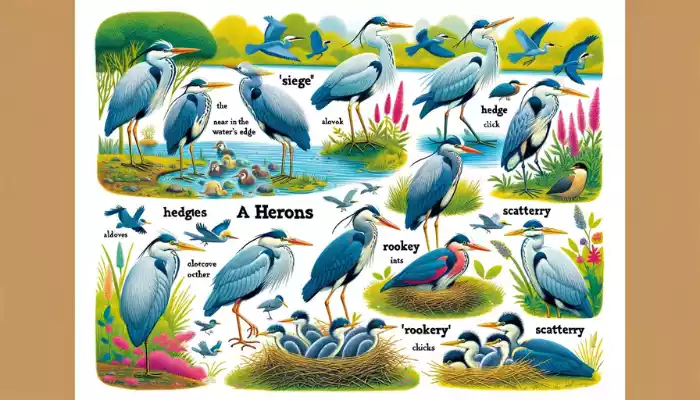Introduction:
Hey kids! Have you ever seen a group of herons and wondered what to call them? Herons are graceful birds, often found standing still in water, waiting to catch a fish. Just like we have different words for groups of people, animals have their own special group names too. Today, let’s dive into the world of herons and discover the unique names we use for their groups!
Birthdays hold a special place in every culture, and Marathi traditions are no exception. Celebrating a birthday in Marathi culture is not just about the cake and candles; it’s about embracing heritage and expressing heartfelt wishes that resonate deeply. Marathi birthday wishes beautifully capture emotions and cultural values.
Collective Noun for Herons
| Noun | Collective Noun | Definition | Example |
|---|---|---|---|
| Herons | Siege | A group, like a small army | “Look at the siege of herons in the marsh!” |
| Herons | Sedge | A group, often seen near water | “A sedge of herons stood silently by the lake.” |
| Herons | Hedge | A group, suggesting a close gathering | “A hedge of herons huddled together in the cold.” |
| Herons | Rookery | A breeding colony | “The rookery of herons was noisy with chicks.” |
| Herons | Scattering | A dispersed group | “A scattering of herons flew over the river.” |
Detailed Explanations and Examples for Herons
1. Siege of Herons
Explanation: This term comes from the word ‘siege,’ which means an army laying in wait, just like herons wait for fish.
Examples:
- “During our boat trip, we saw a siege of herons waiting patiently for their lunch.”
- “In the wildlife documentary, the narrator described the siege of herons by the riverbank.”
- “A siege of herons stood majestically in the shallow waters during sunrise.”
2. Sedge of Herons
Explanation: ‘Sedge’ refers to herons often found in marshy or reedy areas near water.
Examples:
- “A sedge of herons was spotted in the wetlands during our nature walk.”
- “The sedge of herons created a beautiful scene against the setting sun.”
- “We quietly observed a sedge of herons while they hunted for fish.”
3. Hedge of Herons
Explanation: This term paints a picture of herons standing closely together, much like a hedge.
Examples:
- “A hedge of herons gathered at the water’s edge as the tide came in.”
- “In the early morning, we saw a hedge of herons in the foggy field.”
- “The hedge of herons at the park seemed almost like a living fence.”
4. Rookery of Herons
Explanation: ‘Rookery’ is used for a group of herons that come together to breed and raise their young.
Examples:
- “We visited a rookery of herons on the island, where they were nesting.”
- “The noisy rookery of herons was full of life and activity.”
- “In spring, the rookery of herons becomes a busy place with new chicks.”
5. Scattering of Herons
Explanation: This term is used when herons are spread out, not in a close group.
Examples:
- “As we approached, a scattering of herons took flight from the riverside.”
- “From the hilltop, we could see a scattering of herons across the wetlands.”
- “A scattering of herons could be seen in different parts of the lake, hunting alone.”
Conclusion:
Isn’t it fun to learn about the different names for groups of herons? Whether it’s a siege, a sedge, a hedge, a rookery, or a scattering, each name gives us a little clue about how these beautiful birds behave together. Next time you see herons, you can impress your friends and family by using these cool collective nouns!
Quiz Time: Test Your Knowledge on Heron Collective Nouns!
Questions:
1. What do you call a group of herons that are seen together like a small army?
- A) Sedge
- B) Siege
- C) Rookery
- D) Hedge
2. Which collective noun refers to herons that are often found in marshy or reedy areas near water?
- A) Scattering
- B) Hedge
- C) Siege
- D) Sedge
3. What is the term for a breeding colony of herons?
- A) Rookery
- B) Siege
- C) Hedge
- D) Sedge
4. If herons are spread out and not in a close group, what is this called?
- A) Sedge
- B) Hedge
- C) Scattering
- D) Rookery
5. Which collective noun is used for herons standing closely together, like a hedge?
- A) Siege
- B) Sedge
- C) Rookery
- D) Hedge
Answers:
- B) Siege – A siege of herons is like a small army waiting patiently, often near water.
- D) Sedge – A sedge of herons is typically seen in wetland areas.
- A) Rookery – A rookery of herons is where they gather to breed and raise their young.
- C) Scattering – A scattering of herons refers to them being spread out, not close together.
- D) Hedge – A hedge of herons stands closely together, resembling a hedge.
Hope you had fun with the quiz! Keep observing nature and using these cool collective nouns to describe the animal groups you see. Remember, learning can be as fun as a game!

